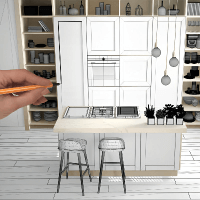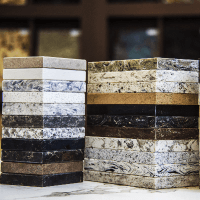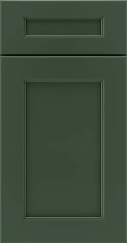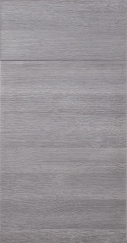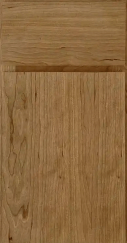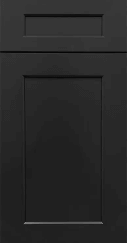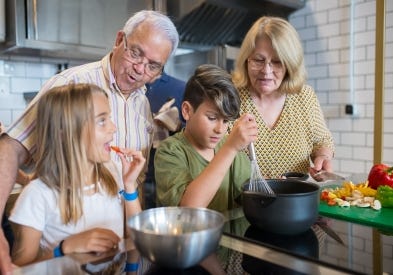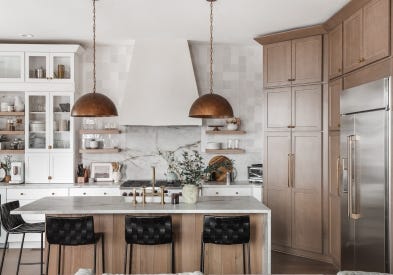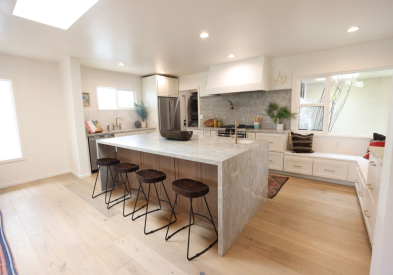We have all heard nightmare stories. A relative or friend we know was chopping veggies in the kitchen and stepped out for a minute, only to come back and find their toddler holding that same chef’s knife. No one wants those scary experiences, or to feel that they and their family are unsafe in the kitchen. In order to curb some of those everyday risks, we created a list of our top 10 basic kitchen safety tips everyone should be using here.


Our kitchen safety tips may be obvious, but they are the most important things to know when it comes to kitchen safety. Everyone needs some day-to-day best practices as a guideline to function well in the kitchen. If you take all these recommendations into account, you will improve the safety of you and everyone else around you while working in the kitchen.
10 Safety Rules in the Kitchen
- Don’t Use a Fork as a Tool
Never stick a fork or knife into a toaster to retrieve the food while it is plugged in. You can get electrocuted. Instead, unplug the toaster, wait for it to cool, and then flip it upside down to get the item out. If you need to use a utensil, grab wooden chopsticks or use a set of wooden tongs. - Be Prepared to Put out Fires
Grease fires have to be put out with baking soda or salt. If you pour water, flour, or sugar on it, you will watch it blow like dynamite. Always make sure you are prepared with the materials you need to put out a fire. - Wear the Right Clothes
Wearing loose clothing is the easiest way to set yourself ablaze in the kitchen. Roll up your sleeves and wear an apron to keep your clothing out of the way if you prefer not to change clothes. - Minimize Extra Cords
Extension cords are best kept in the garage or outside for exterior applications. These extra-long cords are an easy way to cause spills and electrical shock accidents. Keep extension cords out of the kitchen. - Protect Yourself From Boiling Liquids
When boiling water or sauce, stir away from your body to avoid splattering onto your skin. This will prevent any scares or jumps that could knock over something hot and cause another accident. - Clean up Spills and Messes
Clean up every spill immediately because they could catch on fire, create unnecessary smoke, or even cause you to slip and fall. A tidy kitchen is a safe kitchen. - Use Cutting Safety Skills
When chopping foods, cut slowly while keeping the tip of your knife down on the cutting board. This is the easiest way to prevent accidentally stabbing yourself or slicing a finger. Also make sure to move slowly and carefully when carrying a knife in the kitchen to avoid injuring yourself or another. - Keep Your Hands Clean
Cross-contamination can happen quickly. Wash your hands with warm soap and water often. An easy rule is to wash your hands between preparing different food items.
Also, never use the same surfaces to cut veggies or fruit where you were handling raw meat. The best way to avoid E. coli is to designate certain cutting boards for raw meat and others for veggies. - Supervise Children in the Kitchen
Supervise your kids and animals. Always. When kids and pets run through the kitchen, it’s easy for them to leave a trail of toys on the floor that could quickly turn into a tripping hazard. Keeping them out of your preparation and cooking zone will reduce risks of accidents and injury. - Turn Off Your Appliances
Turn your gas range off when you’re done using it. If you smell gas when you shouldn’t, make sure all the burners are turned off, open your windows for ventilation, don’t use any electronics or lighters, and call your gas company.
Whether you are cooking everyday meals or preparing for a holiday gathering, remember to keep these 10 kitchen rules in mind to keep you and your family safe.
Do you need help designing a safer kitchen? Contact a CliqStudios designer today!
Kitchen Safety FAQs
Why is kitchen safety important?
The kitchen holds many different jobs whether that’s cooking, cleaning, or entertaining. As the hub of the home, this space also holds many dangers because of large amounts of electricity, gas lines, and plumbing. Not to mention prepping food can involve sharp knives and bacteria from raw meat.
Kitchen safety is important because any number of things can go wrong if you aren’t using standard practices like cutting safety skills or supervising children in the kitchen. Using safety rules in the kitchen will prevent people from getting hurt, sick, or worse.
What are common kitchen hazards?
Some of the most common kitchen hazards are things like sharp knives, range or cooktop burners, bacteria from cutting boards and cross-contamination, boiling liquids, and grease spills. You can avoid accidents and injuries by simply keeping your hands and cutting boards clean, cutting food slowly, cleaning up spills quickly, and paying close attention to what you’re cooking.
